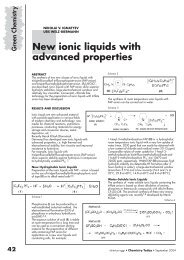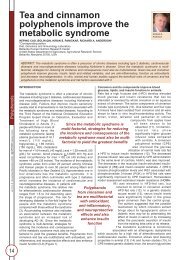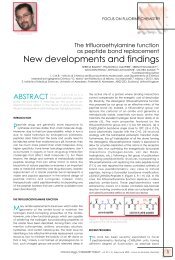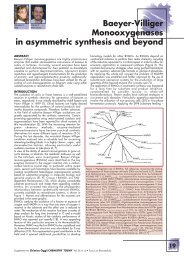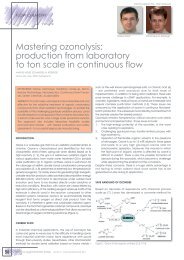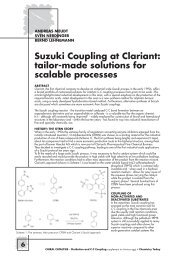Lake Como 2|4 October 2011 - CHIMICA Oggi/Chemistry Today
Lake Como 2|4 October 2011 - CHIMICA Oggi/Chemistry Today
Lake Como 2|4 October 2011 - CHIMICA Oggi/Chemistry Today
You also want an ePaper? Increase the reach of your titles
YUMPU automatically turns print PDFs into web optimized ePapers that Google loves.
SPEAKER SPEAKER SPEAKER SPEAKER SPEAKER SPEAKER SPEAKER SPEAKER SPEAKER SPEAKER SPEAKER SPEAKER SPEAKER SPEAKER SPEAKER SPEAKER SPEAKER SPEAKER SPEAKER SPEAKER SPEAKER SPEAKER SPEAKER SPEAKER SPEAKER SPEAKER SPEAKER SPEAKER SPEAKER SPEAKER SPEAKER SPEAKER SPEAKER SPEAKER SPEAKER SPEAKER SPEAKER SPEAKER SPEAKER SPEAKER SPEAKER SPEAKER SPEAKER SPEAKER SPEAKER SPEAKER SPEAKER SPEAKER SPEAKER SPEAKER SPEAKER SPEAKER SPEAKER SPEAKER<br />
ABSTRACT<br />
BIOGRAPHY<br />
Challenges and opportunities in large scale microwave fl ow chemistry<br />
C. Oliver Kappe a<br />
, Toma N. Glasnov a<br />
, Roman Morschhäuser b<br />
, Matthias Krullb b<br />
, Christoph Kayser b<br />
, Jochen Stock b<br />
a) Christian Doppler Laboratory for Microwave <strong>Chemistry</strong> and Institute of <strong>Chemistry</strong> - Austria<br />
b) Clariant Produkte Deutschland GmbH - Germany<br />
High-speed microwave synthesis has attracted a considerable amount of attention in recent years. Since the fi rst reports on the<br />
use of microwave heating to accelerate organic chemical transformations by the groups of Gedye and Giguere/Majetich in<br />
1986, more than 5000 articles have been published in the area of microwave-assisted organic synthesis (MAOS). Not only is direct<br />
microwave heating able to reduce chemical reaction times from hours to minutes, but it is also known to reduce side reactions,<br />
increase yields and improve reproducibility.<br />
For many years it has been attempted to transfer MAOS into a commercially relevant scale. Apart from missing technological<br />
concepts, the relatively low effi ciency in terms of energy conversion from microwave radiation into heat is a major hurdle which<br />
has so far prevented up-scaling of this promising technology. Well known but undesired up-scaling effects like thermal runaways,<br />
corrosion of pipe work and the reliability of continuous fl ow systems causes severe problems for any engineer dealing with highly<br />
pressurized systems at temperatures of 250°C and above. Nevertheless, the possibility of performing chemical reactions close to<br />
“borderline” conditions for most transformations can open up interesting novel process windows.<br />
Even in the absence of a “specifi c microwave effects”, the potential of volumetric heating can be signifi cant and should become<br />
even more visible with increasing scale. By using several model transformations (e.g. Scheme) we will demonstrate the good<br />
scalability of various synthetic organic transformations under microwave conditions on a multi kg/hour scale.<br />
NH 2<br />
NH 2<br />
+<br />
C. Oliver Kappe<br />
C. Oliver Kappe is Professor of Organic <strong>Chemistry</strong> and Director of the Christian Doppler Laboratory<br />
for Microwave <strong>Chemistry</strong> (CDLMC) at the University of Graz, Austria. He received his diploma- (1989)<br />
and his doctoral (1992) degrees in organic chemistry from the University of Graz where he worked<br />
with Professor Gert Kollenz on cycloaddition and rearrangement reactions of acylketenes. After<br />
periods of postdoctoral research work on reactive intermediates and matrix isolation spectroscopy<br />
with Professor Curt Wentrup at the University of Queensland in Brisbane, Australia (1993-1994) and on<br />
synthetic methodology/alkaloid synthesis with Professor Albert Padwa at Emory University in Atlanta,<br />
USA (1994-1996), he moved back to the University of Graz in 1996 to start his independent<br />
academic career. He obtained his “Habilitation” in 1998 in organic chemistry and was<br />
appointed Associate Professor in 1999. Since <strong>2011</strong> he holds the position of Professor<br />
of “Technology of Organic Synthesis” (Organische Synthesetechnologie) at the<br />
University of Graz. He has spent time as visiting scientist/professor at e.g. the<br />
Scripps Research Institute (La Jolla, USA, Professor K. Barry Sharpless, 2003),<br />
the Toyko Institute of Technology (Toyko, Japan, Professor T. Takahashi,<br />
2008), the University of Sassari (Sassari, Italy, 2008), and the Sanford-Burnham<br />
Institute for Medical Research (Orlando, USA, 2010).<br />
C. Oliver Kappe is currently Editor-in-Chief of the Journal of Flow <strong>Chemistry</strong><br />
(Akadémiai Kiadó) and a member of the Flow <strong>Chemistry</strong> Society. He is also a<br />
board member of the International Society of Heterocyclic <strong>Chemistry</strong> and The<br />
Society of Combinatorial Sciences. In addition he has been an Editor of the Journal<br />
QSAR and Combinatorial Sciences (Wiley-VCH, 2003-2007) and has served/serves on the<br />
Editorial/Advisory Boards of the Journal of Combinatorial <strong>Chemistry</strong> (ACS), Molecular Diversity<br />
(Springer), ChemMedChem and ChemSusChem (Wiley-VCH), Journal of Heterocyclic<br />
<strong>Chemistry</strong> (Wiley-VCH) and a number of other journals.<br />
O<br />
neat (5 M)<br />
N<br />
OH<br />
(excess)<br />
MW, 260 °C (25 bar)<br />
5 L/h (42 s residence time)<br />
N<br />
H<br />
25 mol/h<br />
(3.65 kg/h = 86 kg/day)<br />
Data of energy effi ciency will be presented for some standard reaction types including amidations and esterifi cations. An outlook<br />
on the technological potential of continuous microwave-heated fl ow systems and future targets for further development will be<br />
given.<br />
16<br />
<strong>Lake</strong> <strong>Como</strong><br />
<strong>2|4</strong> <strong>October</strong> <strong>2011</strong>



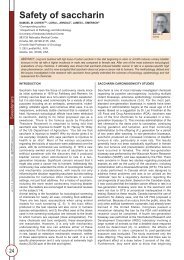
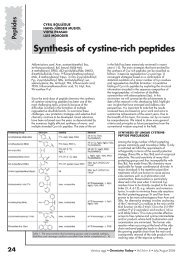
![Pietro Delogu [modalità compatibilità]](https://img.yumpu.com/12255149/1/190x135/pietro-delogu-modalita-compatibilita.jpg?quality=85)
